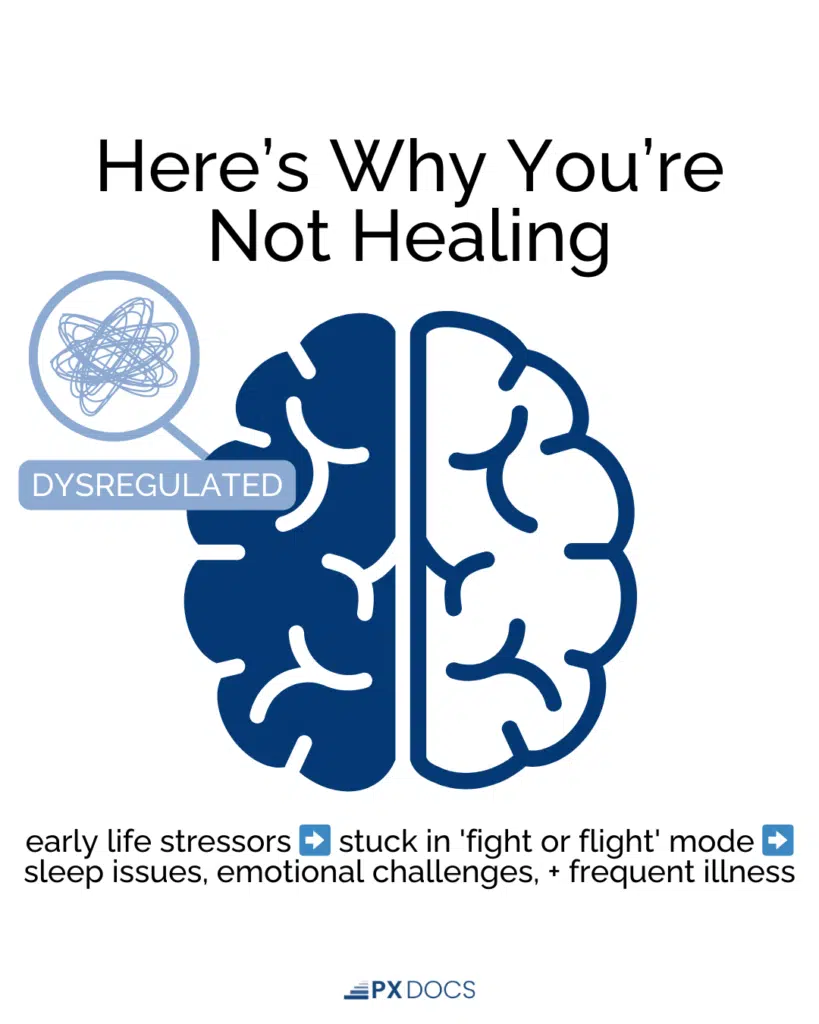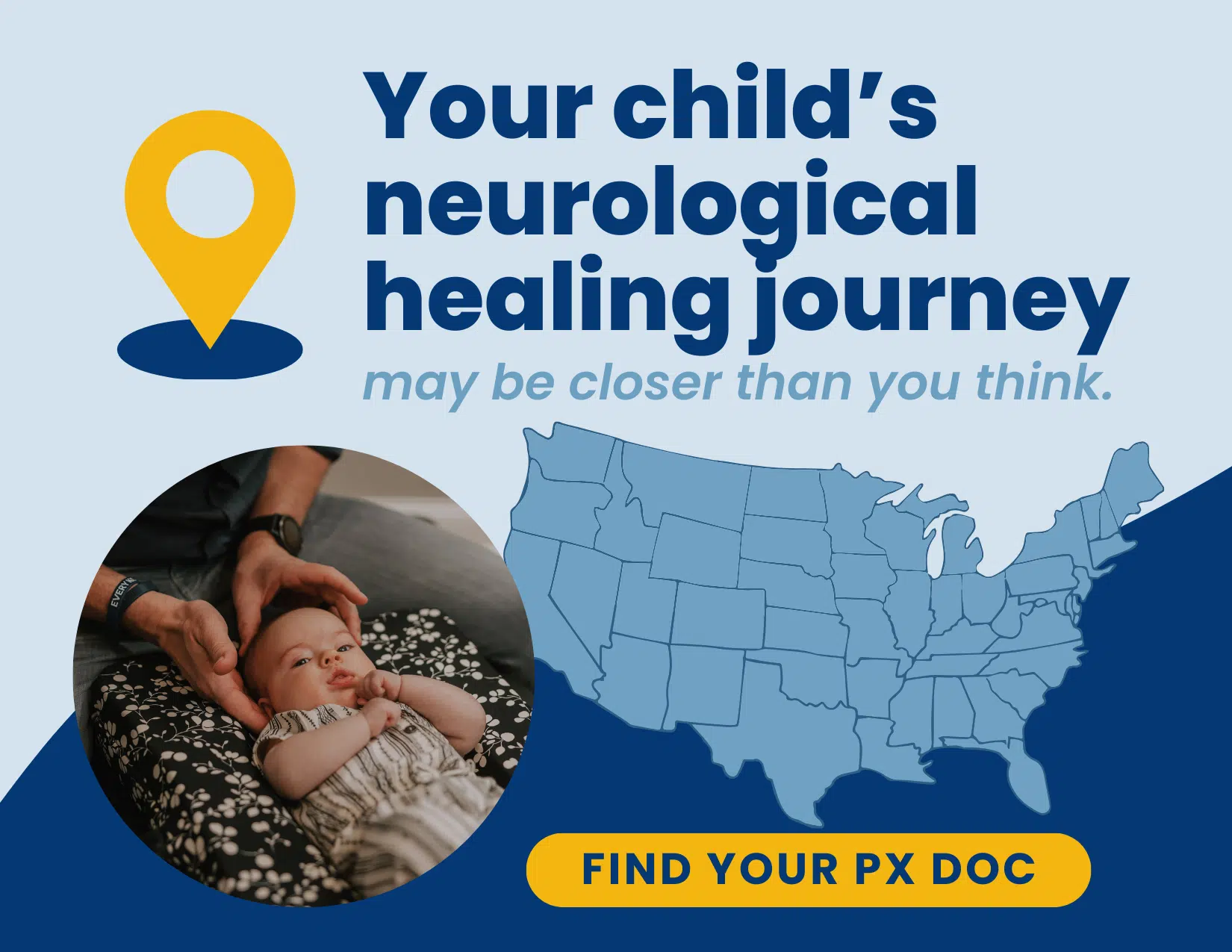As a parent, have you ever wondered why your child seems to struggle with everyday experiences that come easily to others? Maybe they have frequent meltdowns or complain of chronic stomach aches that doctors can’t explain. While these challenges may seem unrelated, they could all be signs of an underlying issue often overlooked – a dysregulated nervous system.
In recent years, there’s been an alarming rise in neurodevelopmental disorders among children, as well as a dramatic rise in the rates of chronic disease overall. While chronic disease was virtually nonexistent in children just a few generations ago, it’s now at a shocking 40% and includes autism, ADHD, anxiety, depression, allergies, autoimmune conditions, obesity, and so much more.
According to the CDC, 1 in 36 children are now diagnosed with Autism Spectrum Disorder, up from the previous rate of 1 in 44. ADHD diagnoses have also skyrocketed, with nearly 12% of children aged 3-17 affected. Since 2010, major depression among teenagers has risen by a staggering 145% in girls and 161% in boys. Similarly, college students have experienced a 134% increase in anxiety and a 106% increase in depression.
And these are just the tip of the iceberg when it comes to the wide range of health issues that stem from a malfunctioning nervous system, commonly known today as nervous system dysregulation.
As Neurologically-Focused Pediatric + Family Chiropractors, we’ve seen firsthand the profound impact that restoring balance to a dysregulated nervous system can have on a child’s health and quality of life. Therefore, in this article, we’ll dive deep into what nervous system dysregulation is, the critical role of the autonomic nervous system, and, most importantly, what you can do to help your child thrive.
Together, we’ll explore a drug-free, holistic approach to supporting your child’s nervous system health and unlocking their full potential.
What is a Dysregulated Nervous System?
A dysregulated nervous system refers to a state of imbalance or dysfunction within the body’s central control network or central nervous system. This intricate system, which includes the brain, spinal cord, and a vast array of sensory and motor nerves, acts as the command center for all bodily functions. When working optimally, the nervous system maintains a delicate balance, allowing us to respond appropriately to our environment and maintain overall health and well-being.
However, when the nervous system becomes dysregulated, it can lead to many symptoms and challenges that affect every aspect of a child’s quality of life. These may include:
- Emotional difficulties, such as anxiety, depression, or mood swings
- Behavioral issues like impulsivity, aggression, or social withdrawal
- Cognitive challenges, including difficulty focusing, learning, or remembering
- Physical symptoms, such as chronic pain, digestive issues, or sleep disturbances
- Immune system dysfunction, such as chronic inflammation, congestion, or coughing
The Role of the Autonomic Nervous System
To understand nervous system dysregulation, knowing about the autonomic nervous system (ANS) is essential. The autonomic nervous system controls involuntary functions like heart rate, breathing, digestion, and blood pressure. It consists of two main branches:
- The sympathetic nervous system (SNS): This is the body’s “gas pedal,” activating the fight-or-flight stress response during times of stress or perceived danger. When the sympathetic nervous system is engaged, it increases heart rate, blood pressure, and muscle tension, preparing the body for action.
- The parasympathetic nervous system (PNS): Known as the “brake pedal” or “rest, regulate, and digest” response, the parasympathetic nervous system promotes relaxation, rest, and healing. It slows heart rate, increases digestion, and allows the body to reduce stress and recover from the fight-or-flight stress response.
A vital key to the parasympathetic “braking + regulating” system is the vagus nerve. We now know that vagal nerve tone and function not only plays an important role in the functions mentioned above, but also in social, emotional, behavioral, and communication functions as well. In short, vagus nerve dysfunction and overall nervous system dysregulation go hand in hand.
In a healthy nervous system, the SNS and PNS work together seamlessly, maintaining a state of balance known as homeostasis. However, when the nervous system becomes dysregulated and “rest and regulate” can’t activate appropriately, this balance is disrupted, leading to dysautonomia.
Causes and Risk Factors of Nervous System Dysregulation: “The Perfect Storm”
As parents, it’s natural to wonder what causes nervous system dysregulation in children. While there is no single answer, research has identified a confluence of factors that can contribute to this condition. At PX Docs, we refer to this combination of stressors as “The Perfect Storm.”
“The Perfect Storm” theory suggests that a child’s sympathetic nervous system can become dysregulated when exposed to various challenges and stressors, often beginning before birth and continuing through early childhood. These factors can include:
Preconception and Prenatal Stress
When a mother experiences chronic stress, her body releases higher levels of stress hormones like cortisol, which can cross the placenta and alter the developing baby’s nervous system. This early exposure to chronic stress can make a child more susceptible to dysregulation and other health challenges down the road that stem from an excessive sympathetic nervous system response.
Birth Trauma and Interventions
The birth process itself can also play a significant role in shaping a child’s neurological health. Traumatic births, often involving interventions like forceps, vacuum extraction, or cesarean section, can cause physical stress and injury to a baby’s delicate nervous system by disrupting brain-body communication right in the critical brainstem area. This delicate and vitally important area functions as “Air Traffic Control” for the entire nervous system and its ability to regulate nearly every single important component of health and development.
Early Exposure to Toxins + Chemicals
As infants grow and develop, they may encounter various toxins and chemicals that can further impact their nervous system health. These may include:
- Chronic illnesses and infections
- Frequent antibiotic use, which can disrupt the gut microbiome and affect the gut-brain axis
- Exposure to environmental toxins, like heavy metals, pesticides, preservatives, etc.
- Sensory overload from bright lights, loud noises, or chaotic environments
These challenges can contribute to developing subluxation and autonomic dysfunction, setting the stage for a dysregulated nervous system.
Lifestyle Factors
Finally, older studies show that modern lifestyle factors can exacerbate or perpetuate nervous system dysregulation in children. These may include:
- Poor diet and nutrient deficiencies, particularly in essential fatty acids and vitamins vital for brain health
- Lack of physical activity and time spent in nature, which can help regulate the nervous system
- Excessive screen time and technology use can overstimulate the senses and disrupt sleep patterns
By understanding the various elements of “The Perfect Storm”, parents can better recognize the potential risk factors and take proactive steps to support their child’s neurological well-being.

Recognizing the Signs and Symptoms of a Dysregulated Nervous System
One of the most challenging aspects of nervous system dysregulation and an inability to reduce stress neurologically is that it can manifest in many symptoms, affecting nearly every aspect of a child’s physical, emotional, and cognitive well-being. As a parent, it’s essential to be aware of these potential signs so that you can seek support and intervention early on.
While every child is unique and may experience symptoms differently, some common signs of a dysregulated nervous system include:
Physical Manifestations
- Chronic pain, headaches, or muscle tension
- Digestive issues, such as constipation, diarrhea, or reflux
- Respiratory problems, like asthma or frequent infections
- Sleep disturbances, including difficulty falling or staying asleep
- Fatigue or low energy levels
- Recurrent illnesses or weakened immune function
- Sensitivities to certain foods, textures, or environmental factors
Cognitive and Emotional Symptoms
- Difficulty concentrating or focusing on tasks
- Poor memory or forgetfulness
- Learning challenges or academic struggles
- Anxiety, fear, or worry
- Mood swings or emotional outbursts
- Difficulty regulating emotions
- Low frustration tolerance
- Sensory processing issues, such as overstimulation or under-responsiveness
Behavioral Signs
- Hyperactivity or impulsivity
- Aggression or oppositional behavior
- Social withdrawal or isolation
- Difficulty with transitions or changes in routine
- Rigid or repetitive behaviors
- Tics or involuntary movements
- Self-stimulatory behaviors, like rocking or hand-flapping
- Avoidance of certain activities or situations
It’s important to note that many of these symptoms can also be associated with other childhood disorders, such as Autism Spectrum Disorder (ASD), Attention Deficit Hyperactivity Disorder (ADHD), Sensory Processing Disorder (SPD), and Pediatric Autoimmune Neuropsychiatric Disorders Associated with Streptococcal infections (PANS/PANDAS).
Research has shown that nervous system dysregulation, particularly autonomic dysfunction and vagus nerve impairment, may be a common underlying factor in many of these conditions. For example, studies have found that children with ASD often exhibit signs of sympathetic dominance and reduced parasympathetic tone, indicating an imbalance in their autonomic nervous system.
Similarly, children with ADHD have been shown to have lower heart rate variability, a marker of autonomic function, compared to their neurotypical peers. This suggests that nervous system dysregulation may play a role in the attentional and behavioral challenges associated with ADHD.
Limitations of Conventional Approaches to Nervous System Regulation
When it comes to addressing a dysregulated nervous system in children, conventional medical approaches often fall short. Many healthcare providers are not well-versed in recognizing and addressing autonomic dysfunction, leading to misdiagnosis, ineffective care plans, and frustration for families.
The signs of nervous system dysregulation and dysfunction actually set in quite early, frequently showing up as colic, constipation, and chronic ear infections in infants and toddlers. However, due to their lack of training and understanding in nervous system regulation and function, these conditions are often dismissed as “normal” by conventional pediatricians, and the parents are told things such as “don’t worry, they’ll grow out of it” when that is sadly not the case.
One of the primary limitations of the conventional approach is its focus on symptom management rather than addressing the root cause of the issue. Medications, such as stimulants for ADHD or antidepressants for mood disorders, may provide temporary relief but do not promote long-term nervous system balance and resilience.
Moreover, the conventional model often relies on a fragmented approach to care, with children seeing multiple specialists for different symptoms without a holistic or whole body understanding of their unique needs. This can lead to conflicting care plans and a lack of coordination between providers, leaving families feeling overwhelmed and unsupported.
At PX Docs, we recognize that a new approach is needed—one that addresses the root cause of nervous system dysregulation and empowers families with the knowledge and support they need to help their children thrive.
How to Regulate the Nervous System: Neurologically-Focused Chiropractic Care
Our approach to supporting children with dysregulated nervous systems is grounded in the principles of Neurologically-Focused Chiropractic Care. This unique, drug-free model identifies and addresses the underlying neurological imbalances contributing to various symptoms and challenges.
At the core of our approach is the understanding that the nervous system is the master control system of the body, regulating every function and process essential for health and well-being. Symptoms can affect multiple systems and organs when the nervous system becomes dysregulated due to subluxation, neurological interference, or autonomic dysfunction.
Our doctors are specially trained to assess and tackle nervous system dysregulation using gentle, non-invasive techniques tailored to each child’s individual needs. By removing interference and restoring proper communication between the brain and body, we help children achieve optimal nervous system function and unlock their innate potential for healing and growth.
Tools for Achieving Nervous System Regulation: Neuro-Tonal Analysis and Adjusting
Neuro-Tonal Analysis and Adjusting is a vital tool for addressing nervous system dysregulation in children. This approach includes:
- Neurological scanning for dysregulation and subluxation
- Muscle tone and posture assessments to pinpoint tension
Neuromotor or “movement-based” assessments of gait, posture, tone, and coordination to help analyze where subluxation may be alter gross and fine motor development
From this analysis, we create personalized care plans featuring gentle adjustments that restore and enhance neurological function, tone, and coordination. This helps children achieve better nervous system regulation, improving their physical, emotional, and cognitive well-being.
INSiGHT Scanning Technology
We also use advanced INSiGHT Scanning Technology to assess nervous system dysregulation, subluxation, and dysautonomia. This tool allows us to:
- Quantify nervous system dysregulation
- Identify areas needing support and adjustments
- Track progress and adjust care plans
- Communicate findings with parents and healthcare providers
By integrating INSiGHT Scanning with our Neurologically-Focused Chiropractic Care, we effectively support children with dysregulated nervous systems and foster lasting health improvements.
Below is a real-life example of a NeuroThermal Scan showing nervous system dysregulation in a teenage patient struggling with constipation, chronic illness, anxiety, and depression.
Empowering Your Family on the Path to Nervous System Regulation
As a parent, you are your child’s greatest advocate and ally. If you suspect that your child may be struggling with a dysregulated nervous system, know that you are not alone—and that there is hope.
At PX Docs, we are committed to empowering families like yours with the knowledge, support, and care you need to help your child thrive. Our Neurologically-Focused Chiropractic Care offers a safe, effective, and drug-free approach to promoting nervous system balance and unlocking your child’s innate potential for health and happiness.
We understand that taking the first step can be daunting, but we are here to guide you every step of the way. The PX Docs Directory can help you find a qualified provider who specializes in supporting children with dysregulated nervous systems.
So don’t wait—take the first step today and discover the life-changing benefits of Neurologically Focused Chiropractic Care. With the right support and guidance, your child can overcome the obstacles of a dysregulated nervous system and embrace a brighter, healthier future.





